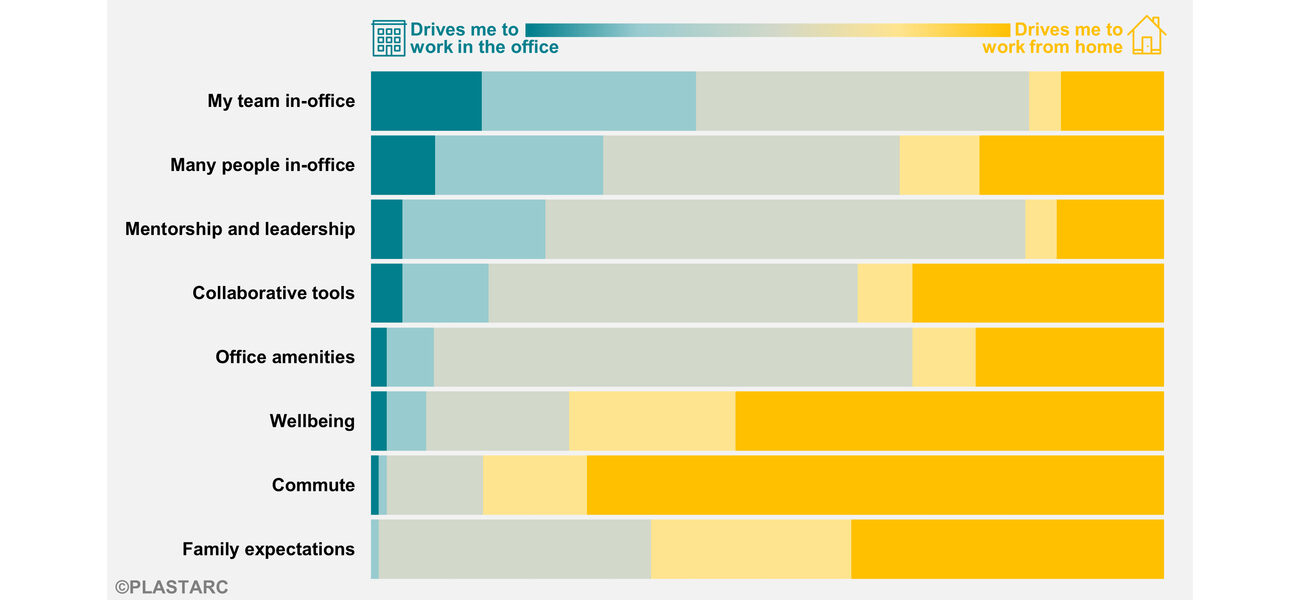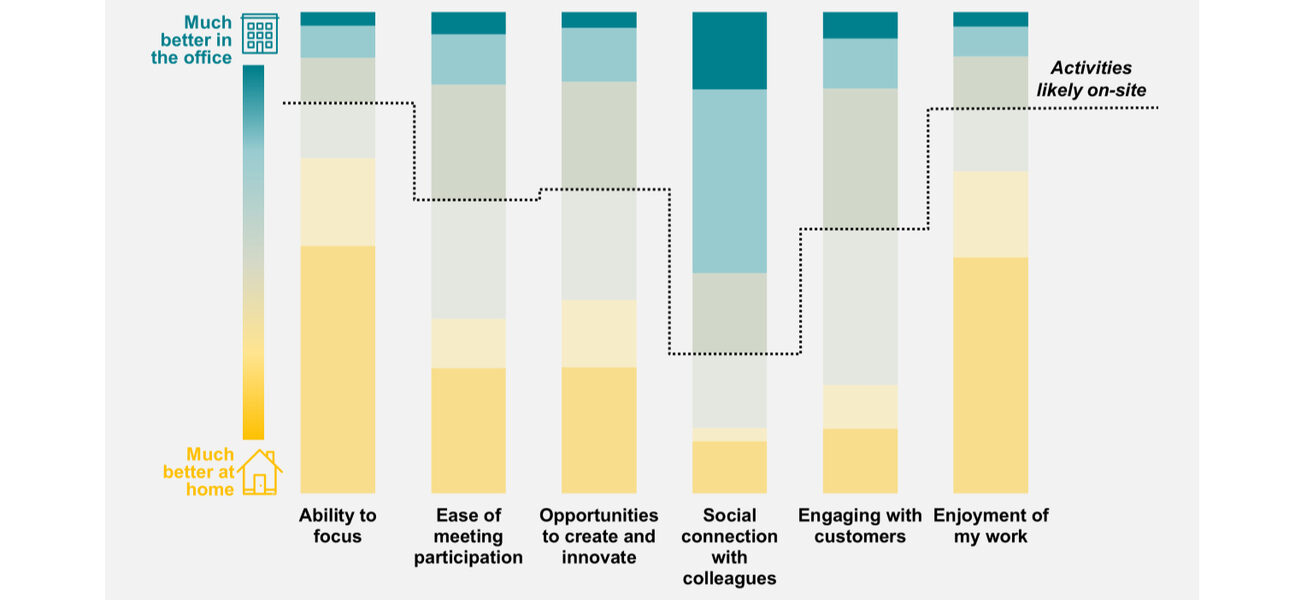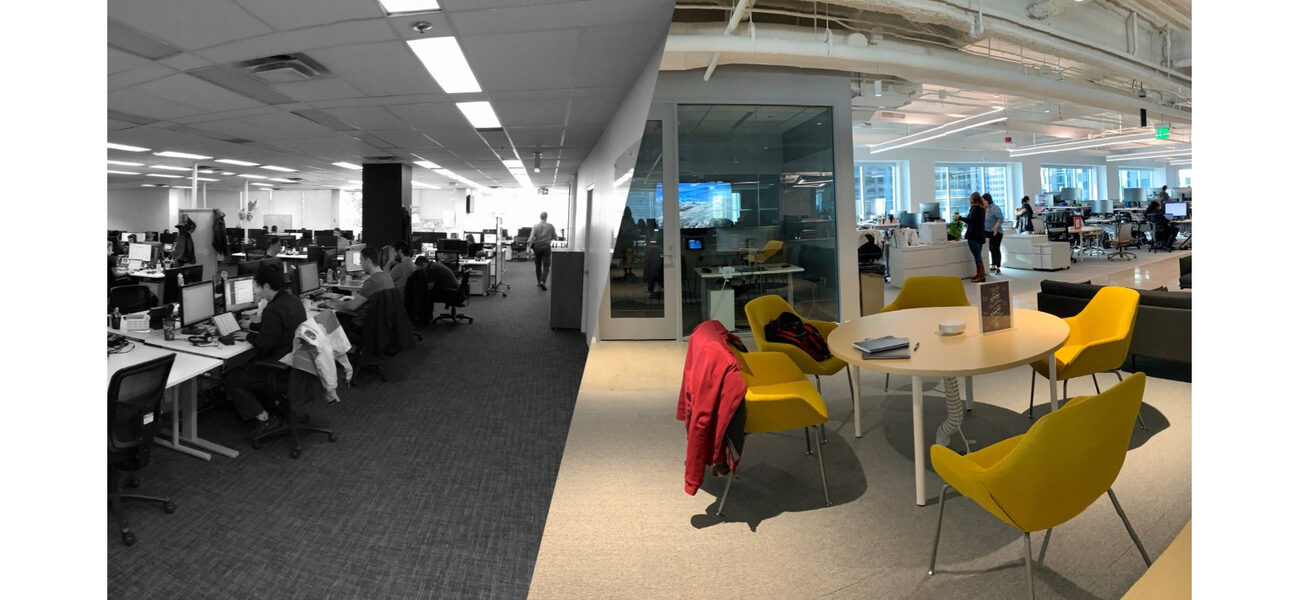As the workplace landscape continues to evolve post-COVID, and organizations rethink their corporate real estate portfolios, companies of all sizes should redefine real estate performance metrics by shifting away from purely occupancy-based statistics, says Melissa Marsh, founder and executive director of PLASTARC. Marsh advocates instead for using tools such as pilot studies and data analysis to help plan corporate spaces that accommodate a workforce that wants to take advantage of work-from-home efficiencies but also wants the flexibility to come into offices that feature more collaboration spaces and activity-based-work (ABW) settings.
“Before COVID-19, many companies were already leaning into the work-from-home model,” says Marsh. “But it is clear now that companies have an opportunity to embrace this paradigm shift and create office spaces that are more flexible and ultimately more productive than ever before.”
Home vs. the Office
In 2022, PLASTARC helped to survey 1,500 employees of a governmental agency as part of a larger study to determine what the future of the U.S. workplace will look like in the next decade.
Sixty percent of the employees surveyed reported that they can focus best while working from home compared to working in the office, and an overwhelming majority found that working from home improved their satisfaction and enjoyment of their work. Significant contributing factors included eliminating long and expensive commutes, enhancing the ability to meet family expectations, and improving their overall personal health and well-being.
Conversely, workers said they believe their ability to create, innovate, and engage with customers is much better while working in the office. Respondents also cited the ability to connect with their colleagues in person at the office as one of the most important benefits of working on site. Other factors driving the decision to work in the office include leadership expectations and enhanced opportunities for self-development.
“People really are the new office amenity, where side conversations, networking, and mentorship opportunities reinforce the importance of the social aspects of work,” says Marsh. “It’s no longer as important to have an office located next to the best restaurants or gyms. Now it is more important to have an office design that encourages people to socially connect with colleagues and engage with customers.” She adds that the data gathered for the survey is remarkably consistent among PLASTARC’s clients across all industries.
Creating Fixed, Fluid, and Flex Spaces
“No matter the size of a company’s real estate portfolio, even companies with just one location and one facility still need to create a diversity of workspaces for people to use when they come into the office,” says Marsh. “We have been advocating for this flexible approach to real estate decision-making since long before COVID-19. Now more than ever, the approach is applicable to a wide range of organizations that are facing a common challenge of underutilized office spaces.”
Marsh explains that thinking of space needs in these three different layers allows organizations to create more flexibility in how to approach real-estate decisions:
- Fixed spaces are core, essential operational spaces.
- Fluid spaces support dynamic work.
- Flex coworking spaces support the surges and situational needs of a workplace.
“Since the opportunity to collaborate is the main reason that people now want to head into the office, creating more flex spaces is critical as companies look to redesign their space,” says Marsh.
After the ABW transformation, PLASTARC conducted post-occupancy research that showed an increased occupancy rate compared to their counterparts who still worked in traditional office settings in other satellite locations.
“This shows the benefit to designing a great environment where people have a sense of autonomy to choose where they work depending on what activity they are doing and the space types that suit the tasks at that moment,” says Marsh.
Use Pilots to Test Configuration Changes
“For many companies it can be overwhelming to address the reuse of multiple offices at the same time, so it is best to conduct small test sites or pilots to determine how to use a larger population of buildings,” says Marsh. “Office changes can be expensive and politically consequential, so getting the sign-off to do a pilot first is often much easier than getting the full project approved.”
In 2022, PLASTARC worked with LPL Financial to conduct pilots in offices in Fort Mill, S.C., and San Diego. The goal was to redesign the office to include more collaboration spaces, since many LPL employees chose to continue working from home on most days. LPL was looking to change their space from a traditional work environment to a more active space where employees have the flexibility to move around and work at different types of furniture.
“We worked with LPL to conduct pilots that allowed employees to experience new space configurations, and then conducted post-occupancy studies with those employees to provide management with evidence-based research that measured employee satisfaction,” says Marsh. “We found that those who experienced the test space were more likely to see the benefits of giving up ownership of a specific desk for shared spaces. It’s easier to get buy-in for widespread change if you can demonstrate the reasoning with a pilot ahead of time.”
It also highlighted the fact that employees felt valued by having the freedom to choose from a variety of space types to do their work. The responses helped management to learn about both communications and signage strategies before rolling out the redesign in other LPL offices. The survey also provided comments about areas of the pilot that employees felt could be improved.
Marsh adds that pilots can be used to establish a learning loop for continuous testing, evaluation, and feedback, and that ideally an organization should be piloting a lot of different things simultaneously. Rather than just testing aspects of space, organizations should also be piloting new operational rules, technologies, programs or events, and how to best communicate these changes.
“If management takes the time to conduct a pilot and survey participants, it is even more important to respect the contributions of these participants by communicating back to them about what changes will take place as a result of their input,” says Marsh. “Any office redesign requires significant communications, but when a company does a drastic redesign, the change management component can be critical to the success of that new space. Everyone wants to feel heard, and communicating with employees may be more important now than ever before.”
An effective change management strategy will help managers take ownership of the workplace messaging, help employees understand what decisions were and were not within the organization’s control, and ultimately help employees to focus on how to do their best work in the new environment, says Marsh.
“When it comes to people-based data, the operationalizing of that data is crucial.”
By Amy Cammell


